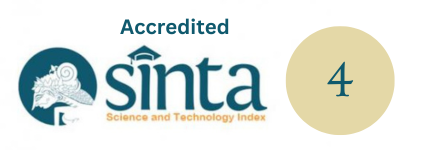Karawitan Composition “Bhuana Santhi” | Komposisi Karawitan “Bhuana Santhi”
DOI:
https://doi.org/10.59997/jurnalsenikarawitan.v3i1.1130Keywords:
Bhuana Santhi, Tabuh lelambatan, Karawitan, Gong Kebyar, BaliAbstract
Bhuana Santhi is a work by tabuh telu lelambatan creations inspired by community activities doing gotong royong, precisely in Lepang Customary Village, Klungkung Regency. This work is still guided by the pattern of traditional work and a little innovation in some parts. As in the section before entering into the pattern of the stone shades played kebyar which according to the stylist an innovation. This work illustrates a sense of togetherness between each other when doing mutual cooperation activities related to piodalan events, namely at Dalem Sila Pegat Temple, Lepang Customary Village, Klungkung Regency. Before the ceremony takes place usually five or six days before, the people of Lepang Indigenous Village carry out mutual cooperation activities both from krama lanang (male) and krama istri (female). The method of creation used in Bhuana Santhi's work is Panca Sthiti Ngawi Sani by I Wayan Dibia which includes the ngawirasa (Inspiration) stage, the ngawacak (exploration) stage, the ngarencana (conception), the ngawangun (execution), and the stage of worship, (production), making it easier for stylists to realize the work of Bhuana Santhi. Bhuana Santhi uses media revealed Gamelan Gong Kebyar. The structure of Bhuana Santhi consists of three parts, namely the fumigation, manning and the drilling and the duration of the entire Bhuana Santhi work is 12 minutes.
Downloads
References
A.A.M.Djelantik. (2004). Estetika Sebuah Pengantar (2nd ed.). Masyarakat Seni Pertunjukan Indonesia (MPSI).
Adnyana, I. M. P. I. G. Y. H. S. (2019). Patra Dalung, Sebuah Komposisi Karawitan Bali Yang Lahir Dari Fenomena Sosial Di Desa Dalung. Kalangwan: Jurnal Seni Pertunjukan, 5(1), 61–67. https://jurnal.isi-dps.ac.id/index.php/kalangwan/article/view/670
Dibia, I. W. (2017). Kotekan Dalam Musik Dan Kehidupan Bali. Bali Mangsi Foundation dan ISI Denpasar.
Dibia, I. W. (2020). Panca Sthiti Ngawi Sani: Metodologi Penciptaan Seni. Pusat Penerbitan LP2MPP Institut Seni Indonesia (ISI) Denpasar.
Dibia I Wayan. (2012). Ilen Ilen SENI PERTUNJUKAN BALI. Bali Mangsi.
I Gede, Y. (2010). Pengertian Tabuh Lelambatan Klasik Pegongan. Artikel Bulan Mei 2010, 8, 1–3.
Kariasa, I. N. (2012). Deskripsi Karya Seni "Gamelan Tajen” Fenomena Sosial Sebagai Sumber Inspirasi Penciptaan. Institut Seni Indonesia (ISI) Surakarta.
Ngurah I Gusti Made. (1999). Buku Pendidikan Agama Hindu (Maswinara I Wayan (ed.)). PARAMITA.
Pradana, K. A. W., & Garwa, I. K. (2021). Samirata a Musical Art Composition Creative Percussion | Samirata: Sebuah Karya Komposisi Seni Karawitan Tabuh Kreasi. Ghurnita: Jurnal Seni Karawitan, 01(03), 145–151. https://jurnal2.isi-dps.ac.id/index.php/ghurnita/article/view/355
Pryatna, H. S. I. K. S. I. P. D. (2020a). Permainan Kendang Bali. Dewaruci, 15(2), 90–100. https://doi.org/10.33153/dewaruci.v15i2.2991
Pryatna, H. S. I. K. S. I. P. D. (2020b). TEKNIK PERMAINAN KENDANG TUNGGAL PADA GAMELAN BALI. Pusat Penerbitan LP2MPP ISI Denpasar. http://repo.isi-dps.ac.id/3795/
Pryatna, I. P. D. H. S. (2020). Konsep Musikal Instrumen kendang Dalam Gamelang Gong Kebyar Bali. Resital: Jurnal Seni Pertunjukan, 21(2), 73–84. https://doi.org/10.24821/resital.v21i2.4220
Rembang, I. N. (1985). Hasil Pendokumentasian Notasi Gending-Gending Lelambatan klasik pegongan daerah bali. Departemen Pendidikan dan Kebudayaan.
Sadguna, I. G. M. I. (2010). Kendang Bebarongan Dalam Karawitan Bali Sebuah Kajian Organologi. KANISIUS (Anggota IKAPI).
Sena, I. (2017). Implementasi Konsep" Ngayah" Dalam Meningkatkan Toleransi Kehidupan Umat Beragama di Bali. Makalah Disajikan Dalam Seminar Nasional Fakultas Brahma Widya, IHDN, Denpasar, 25–26.
Suadnyana, I. B. P. E. (2018). Kajian Nilai Pendidikan Agama Hindu Dalam Konsep Manyama Braya. Jurnal Pasupati, 5(1), 48–60. https://doi.org/http://dx.doi.org/10.37428/pspt.v5i1.128
Sukmadinata, S. N. (2005). Metode Penelitia. Bandung: PT Remaja Rosdakarya.








